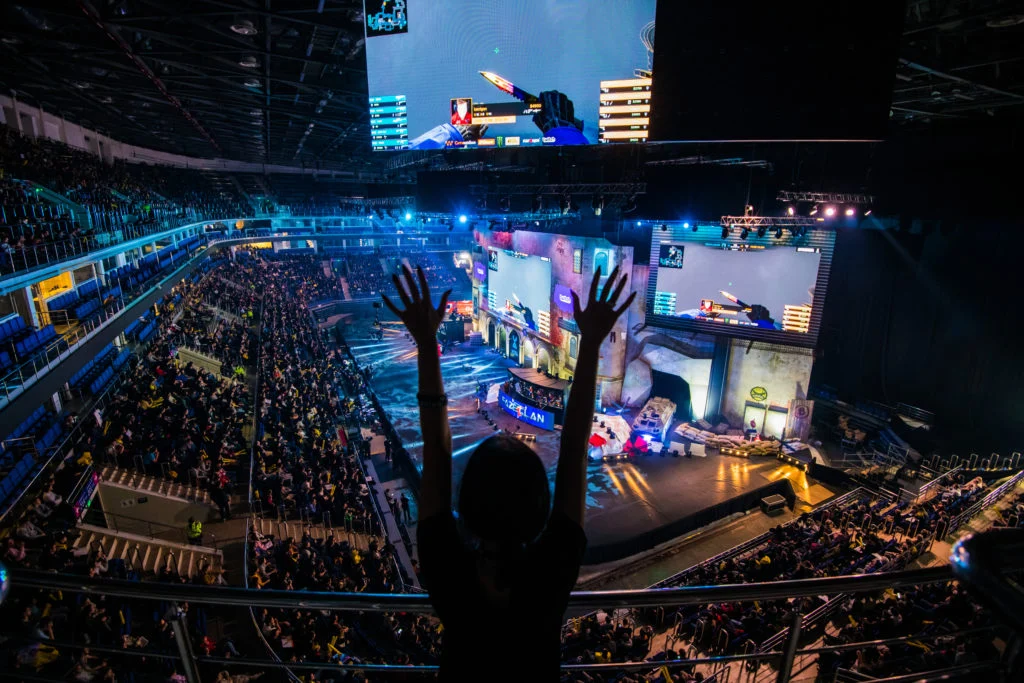Land-based casinos have taken steps to present esports venues alongside their offerings, but have struggled to actually have any real success at using the vertical to boost interest in their core products. This may change as those who grew up with video gaming age into the typical casino demographic, Paul Girvan writes, but only if operators make a better effort of integrating esports into their venues.
In 2015, after a tiring couple of days at G2E, I, along with a group of curious industry folks mostly from the igaming sector, went to tour the esports lounge at Downtown Grand.
This was a visionary concept in its infancy and was admittedly developed in a perfunctory manner. In this early form the venue was underwhelming.
Located in an alcove off the casino floor, near an entrance but close to a bar, the facility was small -probably around 700 square feet – and consisted of a handful of computer stations and a large screen on the wall. Chairs and tables holding the equipment were stock items and decoration and amenities were limited. The venue was the site of a tournament for local players. Attendance during the tournament was brisk but evaporated thereafter. Slot machines were nearby, as was a bar.
While the bar received some traffic, play at the nearby slots was minimal. Maybe the table games and poker room received some boost, I don’t know, but I doubt it. By 2022, with all the hoopla surrounding esports it might have been expected that the esports lounge would have developed to become a constituent component in many casinos across the US.
Other than a smattering of esports tournaments and the development of a couple of massive bespoke esports arenas associated with Las Vegas casinos, esports in 2022 are largely absent from regional casinos.
For 20 years, casinos have lamented the aging demographics of their customers with the refrain of, “Our customers are literally dying”. These predictions of a dying clientele have not come to be, mainly because as some die (inevitable) others age (also inevitable) into the demographic that seeks entertainment through casino gaming.
However, we may be on the cusp of a “sea change” as the demographic that grew up with video games now begins to age into the demographic that forms the core of casino gamers. These potential guests grew up in the rich graphics, high energy adrenaline rush of competitive video gaming. While some will visit casinos, many more will find the modern casino environment stifling, boring and unfulfilling. For many years now esports has been touted as a possible avenue to win over these customers.
There have been other attempts to broaden the age appeal of casinos including trendier F&B offerings, carefully targeted entertainment headliners, and more recently the advent of ‘skill’ games on the slot floor, but esports has been a consistent feature in casino executive’s minds as an avenue to address this market segment. An avenue that to date has largely not met expectations.
You could make the case that esports has been around in a rudimentary form since the 1970s, but it was only with the rapid acceleration in computer technology and the internet in the late 1990s and early “noughties” that what we now commonly refer to as esports began to develop.
With the rise of streaming (Twitch and YouTube), sponsorships by video game companies and professional esports teams and players, esports by 2010 had matured, attracting hundreds of millions of viewers online. By the late 2010s, it was estimated that the total audience of esports would grow to 454 million viewers, with revenue increasing to more than US$1 billion.
There can be little doubt that esports has become firmly entrenched as an entertainment option for a large swathe of the population and has become engrained in society. And any parent (and their lightened wallet) with a teenager can attest to the fact it generates significant revenue. But video gaming and esports is not the sole purview of the teenager in his bedroom. Consider that an 18–20-year-old enthusiast of video games in 2000 is now 40 years old and firmly within the coveted casino demographic.
Casinos have primarily attempted to capitalize on this aging esports market by hosting major tournaments. I have helped arrange at least one of these. While these tournaments help elevate the casino in the consciousness of esports fans, create media notoriety and generate some revenues by filling hotel rooms and driving ticket sales there are limitations, among them:
- There is little crossover for gaming revenue as a result the casino essentially acts as dormitory for esports players and spectators
- There is only limited uplift in other areas of a casino resort such as retail or food and drink
- A tournament is generally associated with one or other of the common franchises thus limiting appeal even within the esports community
- A tournament is a one-off event lasting only a limited time and even if there were crossover it would not significantly move the casinos bottom line on an annualized basis
While tournaments are nice and provide great press and notoriety, they don’t really solve the casinos problem. They are too ephemeral. For most casinos tournaments have been viewed as a vehicle to ‘dip your toe in the water’ without making a significant commitment in dollars and time.
Tournaments are certainly part of the package a casino should look at, but they are very much limited in achieving the goal of expanding the casino gamer market into this demographic in a meaningful way. The solution has remained elusive. However, it now seems that many of the components that would be necessary to provide a significant, sustainable, and meaningful impact on casino revenue are beginning to fall into place. To capitalize on this confluence of factors, investment in facilities is required.
Several threads have come together that, if exploited and presented in a unified concept by casinos, have the potential to generate new revenues and provide incremental revenue throughout the property.
Forget the esports arena, only major players in markets such as Las Vegas with its worldwide draw (Luxor) can possibly justify such astronomical levels of investment in bespoke esports Arenas. For the regional casino, a reimagined esports lounge is a more realistic possibility. Consider the following factors that have emerged over the last few years:
- esports players have continued to age into the casino gaming market demographic.
- The pandemic halted most sporting events leaving esports as one of the only alternatives which has boosted its appeal generally, and specifically as a betting product.
- The rise of igaming and more significantly the development of esports books has created the infrastructure to capture a significant betting market. (esports betting is 100% legal in Nevada, NJ, Tennessee, and West Virginia. Esports betting is regulated, but not 100% legal in Arkansas, Delaware, NY, Iowa, Illinois, Michigan, Rhode Island, Montana, New Mexico, Oregon, and Pennsylvania). In 2020, according to Eilers & Krejcik, it was estimated that 6.5 million people are wagering on different esports games.
- The ongoing development of ‘games of skill’.
- The technological revolution continues, and the broad appeal of livestreaming has exploded (Twitch and Youtube).
- Esports has entered the broader society. Consider that in the US 175 universities and colleges have officially recognized collegiate esports programs. In the US there are now numerous esports teams, leagues and organizations.
- The pandemic wrought some changes in the casinos. Gone are the ubiquitous buffets replaced by more varied food courts. The lower price points, variety and time savings offered at food courts provides a more appealing option to the esports enthusiast.
Few casinos can afford to develop a large dedicated esports arena, but within reach of many is the ability to develop a esports lounge to cater to this significant tech savvy market. To do so it takes commitment and dollars and some risk, but the factors that could ensure success are present. Key in this is providing an environment that speaks to these guests, treats them with respect, offers the potential to create a profit center while maximizing cross-over to other casino resort elements.
If the premise that esports offers an avenue to a potentially large untapped and younger demographic for casinos is accepted, what factors should be considered to increase the likelihood of success. At a stripped-down level there are four: The facility, creation of multiple revenue streams, location and integration with the casino resort and embedding in the gamer community.
The Facility
The facility itself should be designed specifically for the clientele and should reflect the demographic and the function of the space. It cannot be simply four walls. It must be segregated into functional areas. The facility must include state-of-the-art equipment and internet connectivity (potentially provided by manufacturer sponsorships). Specifically, it should include the following elements:
- Individual game stations.
- Multi-player game stations.
- Suites that provide multi-player game stations plus seating for viewers with F&B service (a la Top Golf Suites)
- An appealing lounge area with bar and limited F&B service with video feeds/live streaming from games being played on-site and from major tournaments worldwide.
- An esports book with live streaming and video screens.
- A gaming area with ‘games of skill’, retro video and pinball games, and potentially limited table games if possible given regulatory, security and surveillance strictures.
- A retail area featuring high end gaming equipment (from major equipment manufacturers and sponsors)
Multiple Revenue Streams
In the definition of the facility above multiple revenue streams are created, including:
- Facility rental for game stations and suites
- food and beverages
- Retail and manufacturer sponsorships
- esports betting
- Other gaming revenues from ‘games of skill’ and retro games
- Regional and local tournament fees
The presence of these multiple revenue streams greatly increases the likelihood of success.
Location and Integration with the Casino Resort
The esports lounge cannot be treated as an afterthought tucked away in some underutilized alcove. It should be treated much like a sportsbook: clearly visible and easy to find.
It should be close to the Food Court where the variety, pricing and rapid service is more likely to appeal to this demographic. It should be close to the Sports Book and table game area, with which it is likely to share greater crossover.
The slot floor should be adjusted to increase the concentration of ‘games of skill’ in proximity to the esports lounge (offering a testing ground for these machines).
Realignment of the entertainment schedule should also be considered to provide occasional acts that would appeal to this specific demographic. Most though, not all casinos, have a significant events center, these should be used periodically for larger regional or national tournaments and to showcase visiting internationally renowned esports teams. Through such integration the attractiveness of the esports lounge is magnified, and the likelihood of resort-wide benefits increased.
Embedding in the Gaming Community
The esports lounge conceived here has the potential to become the hub of the local gamer community. This could be furthered in a number of ways:
- A concerted and deliberate effort to reach out to the local gamer community prior to opening to publicize the facility
- Organizing local and regional tournaments
- Enlisting the support and sponsorship of equipment manufacturers and their marketing ‘reach’
- The go to source for locally available high end gaming equipment
- Developing local amateur teams (in tribal casinos this could include the development of teams representing both the local community and the tribe)
- Acting as the ‘home field’ for local university and college esports teams
- Live streaming of local, regional, national, and international tournaments
While major Las Vegas casinos have captured the limelight with dedicated esports arenas smaller regional casinos have been left devoid of a means to approach this market. The esports lounge as described above offers a viable solution for smaller regional casino resorts.
Yes, esports tournaments have been held at regional casinos, but these are one-off events, unable to significantly move the needle on annual revenues or to provide a meaningful avenue to attract players on a regular basis. Such tournaments have been criticized for a lack of crossover revenues, with casino executives complaining that they are reduced to acting as a ‘dormitory’ for esports players.
These are understandable critiques but largely predictable given the lack of attention to the quality, customization and content of the experience provided. To be fair casinos have for the most part been cautious and their sallies into this space have been experimental in nature and of short-term duration.
It is now opportune, with the confluence of external factors, to create a viable esports lounge to capitalize on this market. Operators should take the risk and invest. The synergies are there, but the investment and commitment remain elusive.
If casinos resorts shy away from this market segment preferring to stick with the familiar, they will cede the initiative to other non-casino venues, losing ground and opportunity that will be difficult to recapture.



